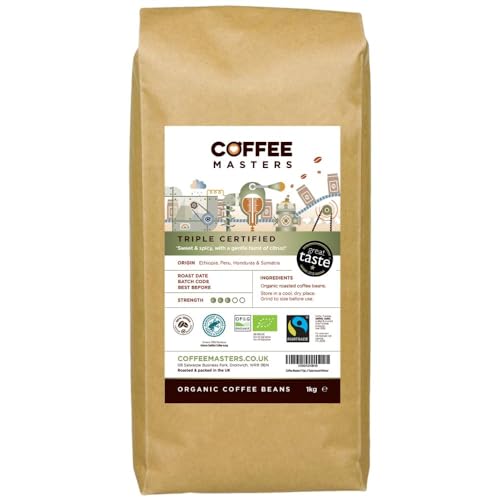Coffee Beans Coffee 101:"The Complete" Guide For Beginners

What Are Coffee Beans?
Coffee beans are the seeds of a type of cherry fruit or plant. They grow best in climates and at altitudes comparable to where they are grown and require certain levels of soil composition, moisture and other factors to bring them to fruition.
In addition to flavor, they offer numerous health benefits. Coffee is rich in amino acids trigonelline, which upon roasting transforms into nicotinic acids (a water-soluble B vitamin). It also contains phenolic acids, including chlorogenic acid, which helps reduce blood sugar.
Origin
The majority of people know what a roasting bean looks like, but few are aware that it was originally a fruit. A coffee bean is a seed produced by a specific species of Coffea plant. In most cases, the berries split and each one contains two beans. However, in around 5 percent of the beans that are harvested, only one bean splits. This kind of bean is called a "peaberry" and is typically sorting by hand and sold in separate packages.
The "Bean Belt" is an area of the world situated between the Tropics of Capricorn & Cancer is where the majority of coffee is produced. Most countries produce coffee using various techniques, each of which has its own distinct flavor and distinctive characteristics.
The exact history of coffee is in disagreement, but it is thought that the first coffee plants were indigenous to Abyssinia in the present day Ethiopia. The most well-known story is about a goatherd called Kaldi who saw his goats screaming and excited after eating the bright red berries on nearby trees. Kaldi was able to taste the berries and felt a rush of joy. He then introduced the drink to others in his community and it gained popularity. In the 15th and 16th centuries, it became popular throughout the Islamic world, despite that Islamic authorities declared it to be intoxicating. an.
Flavor
The taste of coffee beans is dependent on the region and species of the coffee plant, but also on the soil elevation, farming techniques, and roasting process. You can create different flavors by adjusting the temperature and duration of roasting as well as the air flow during roasting.
The kind of syrup used to flavor coffee beans can affect the taste. After roasting the beans, they are spray-painted with oil-based flavoring agent and then allowed to sit for 30 minutes. This allows the beans to absorb the oils. The flavored coffee beans are then sorted and graded.
The addition of flavor to coffee beans is a simple and cost-effective method to alter the flavor of coffee without altering its color or texture. The flavor of coffee that is flavored is often stronger than the regular unflavored coffee. This is due to the fact that the flavored beans are submerged in flavoring syrup.
The flavor of coffee is also affected by the spices that are added to it as it is stored. Whole spices, such as cinnamon sticks, vanilla and cocoa beans can be combined with freshly roasted coffee beans to create a distinctive flavor. This is especially effective when coffee beans that have been roasted are kept in an aerated container.
Health Benefits
Coffee beans are believed to have many health benefits. These benefits include reducing the risk of suffering from Alzheimer's and Parkinson's disease, liver disease and other ailments. The caffeine found in coffee beans has been proven to improve memory and cognitive function. Coffee contains antioxidants that combat free radicals. Coffee's chlorogenic acid is believed to prevent chronic illnesses such as heart diseases and diabetes.
Consuming coffee beans has been linked with lower risk of developing type 2 diabetics. coffee bean company Coffeee have also discovered that coffee beans can lower the risk for Parkinson's liver disease, Parkinson's disease, as well as cancers of the colon and colorectal system. Coffee has been linked with increased brain function and may even aid in preventing depression. Different studies have demonstrated that the presence of certain acids in coffee can increase levels of serotonin and dopamine.
Although drinking coffee beans in raw form is a healthy option for many but it shouldn't be utilized to replace a healthy diet and regular exercise. It is recommended that not more than 30 cups of coffee beans are consumed daily, and the effect of caffeine should not exceed as it can cause side effects including jitters, anxiety and insomnia. Also, if suffer from acid reflux or have an insensitive stomach, you should avoid coffee beans.

Preparation
The coffee plant produces two seeds (or bean) that are arranged on top of each other. Each fruit has an outer skin called the exocarp as well as an extremely thin layer of pulp on top. The coffee seeds are sucked from their covers, separated and cleaned prior to roasting. The beans can be processed in three different ways: dry, moist, or a hybrid that is known as wet-processed. The beans are then roasted and can be ground, or left in their entirety.
The variety of coffee bean varieties offers different flavor profiles to enhance a variety of drinks, dessert, and food recipes. The best choice for a recipe will depend on the flavor and texture you'd like to achieve.
The coffee bean is covered with wax that is intact when it is whole. This layer protects the aroma and flavor compounds of the coffee from air. After grinding the coffee beans, these compounds are exposed and lose their taste with time. When you make coffee, the temperature of the water you use is critical for preserving and capturing the flavors. Pouring at a lower temperature releases fewer of the nascent flavors, while a higher temperature releases more. It is important to brew coffee at the temperature that you like. If you don't take this into consideration then the taste will become bitter or sour.
